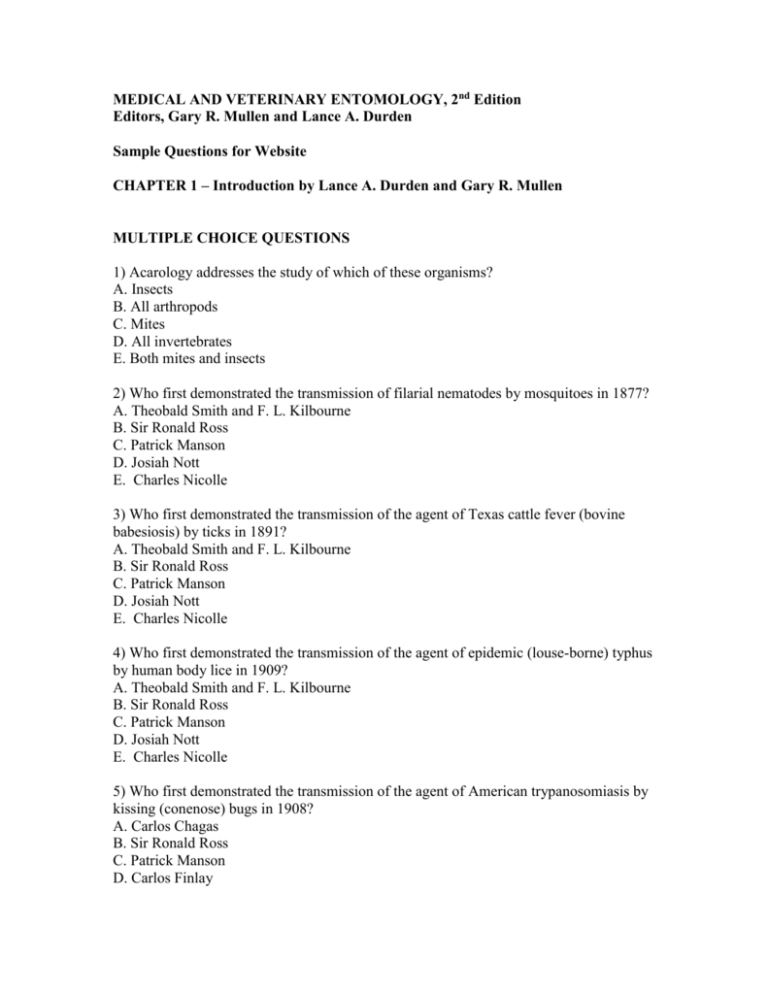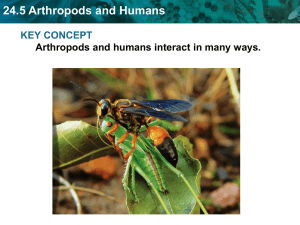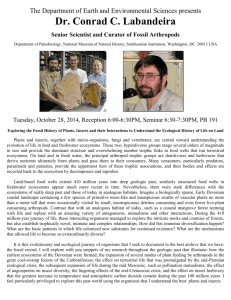MEDICAL AND VETERINARY ENTOMOLOGY, 2nd Edition
advertisement

MEDICAL AND VETERINARY ENTOMOLOGY, 2nd Edition Editors, Gary R. Mullen and Lance A. Durden Sample Questions for Website CHAPTER 1 – Introduction by Lance A. Durden and Gary R. Mullen MULTIPLE CHOICE QUESTIONS 1) Acarology addresses the study of which of these organisms? A. Insects B. All arthropods C. Mites D. All invertebrates E. Both mites and insects 2) Who first demonstrated the transmission of filarial nematodes by mosquitoes in 1877? A. Theobald Smith and F. L. Kilbourne B. Sir Ronald Ross C. Patrick Manson D. Josiah Nott E. Charles Nicolle 3) Who first demonstrated the transmission of the agent of Texas cattle fever (bovine babesiosis) by ticks in 1891? A. Theobald Smith and F. L. Kilbourne B. Sir Ronald Ross C. Patrick Manson D. Josiah Nott E. Charles Nicolle 4) Who first demonstrated the transmission of the agent of epidemic (louse-borne) typhus by human body lice in 1909? A. Theobald Smith and F. L. Kilbourne B. Sir Ronald Ross C. Patrick Manson D. Josiah Nott E. Charles Nicolle 5) Who first demonstrated the transmission of the agent of American trypanosomiasis by kissing (conenose) bugs in 1908? A. Carlos Chagas B. Sir Ronald Ross C. Patrick Manson D. Carlos Finlay E. Walter Reed 6) Who definitively demonstrated the transmission of Yellow Fever virus by mosquitoes in 1900? A. Carlos Chagas B. Sir Ronald Ross C. Patrick Manson D. Carlos Finlay E. Walter Reed 7) Who first demonstrated the transmission of the causative agent of Rocky Mountain spotted fever by ticks in 1906? A. Theobald Smith and F. L. Kilbourne B. Howard Taylor Ricketts C. F. P. Mackie D. Carlos Finlay E. Charles Nicolle 8) Which insects are included in the order Blattaria? A. Cockroaches B. Lice C. True Flies D. Fleas E. Beetles 9) Which insects are included in the order Phthiraptera? A. Cockroaches B. Lice C. True Flies D. Siphonaptera E. Beetles 10) Which insects are included in the order Coleoptera? A. Cockroaches B. Lice C. True Flies D. Fleas E. Beetles 11) Which insects are included in the order Diptera? A. Cockroaches B. Lice C. True Flies D. Fleas E. Beetles 12) Which insects are included in the order Siphonaptera? A. Cockroaches B. Lice C. True Flies D. Fleas E. Beetles 13) Which arthropods are included in the order Araneae? A. Scorpions B. Spiders C. Ticks D. Solpugids E. Mites 14) How many stages of immune responses are recognized in humans and animals repeatedly exposed to bites or stings of the same or antigenically related arthropods? A. 10 B. 6 C. 3 D. 12 E. 5 15) What is myiasis? A. Extreme hypersensitivity to arthropod bites or stings B. Parasitism by lice C. Parasitism by fleas D. Invasion of host tissues by fly larvae E. A parasite avoidance response by the host 16) What is an arbovirus? A. A virus transmitted by arthropods B. A virus found on trees C. A virus only found in insects D. A virus only transmitted by ticks E. A virus only transmitted by mosquitoes 17) How does biological transmission differ from mechanical transmission by a vector? A. In biological transmission, the agent undergoes a developmental cycle in the vector before it can be transmitted to another host B. In biological transmission, the agent does not undergo a developmental cycle in the vector before it can be transmitted to another host C. In biological transmission, another species of arthropod facilitates transmission D. In biological transmission, there is no reservoir host E. In biological transmission, 2 or more pathogens are always transmitted at the same time by the vector 18) What is entomophobia? A. Fear of spiders B. Fear of mites C. An imagined skin infestation by arthropods D. An imagined internal infestation by arthropods E. Fear of insects 19) What is another term for delusory parasitosis? A. Acarophobia B. Myiasis C. Apyrase D. Ekbom syndrome E. Arachnophobia 20) What is an analgesic? A. A factor that prevents blood from clotting B. A local pain killer C. A parasitic fly D. A factor that dilates blood vessels E. A factor that promotes healing after an insect bite 21) What is an anticoagulant? A. A factor that prevents blood from clotting B. A local pain killer C. A parasitic fly D. A factor that dilates blood vessels E. A factor that promotes healing after an insect bite 22) What is another term for Morgellons Disease? A. Acarophobia B. Myiasis C. Unexplained dermopathy D. Immunosupression E. Immunomodulation 23) How can a few species of walkingsticks (stick insects) cause medical/veterinary problems? A. By stinging B. By spraying defensive secretions that can irritate the skin C. By transmitting pathogenic viruses D. By transmitting pathogenic bacteria E. By laying their eggs under the skin 24) Which of these insects often cause inhalational allergies in humans following large emergences of the adult insects? A. Mayflies B. Walkingsticks (stick insects) C. Thrips D. Earwigs E. Praying mantids 25) Which of these blood-feeding insects complete their entire life cycle on the host? A. Fleas B. Mosquitoes C. Sucking lice D. Kissing (conenose) bugs E. Bed bugs 26) Which of these groups of arthropods transmit Yellow fever and West Nile viruses? A. Ticks B. Kissing (conenose) bugs C. Deer flies D. Mosquitoes E. Blackflies 27) Which of these groups of arthropods transmit the causative agents of Rocky Mountain spotted fever and Babesiosis? A. Ticks B. Kissing (conenose) bugs C. Deer flies D. Mosquitoes E. Blackflies 28) Which of these groups of arthropods transmit the causative agents of Malaria to humans? A. Ticks B. Kissing (conenose) bugs C. Deer flies D. Mosquitoes E. Blackflies 29) Which of these groups of arthropods transmit the causative agents of Plague and murine (endemic) typhus to humans? A. Fleas B. Kissing (conenose) bugs C. Sucking lice D. Chewing lice E. Cockroaches 30) How can some millipedes cause medical/veterinary problems? A. By stinging B. By spraying defensive secretions that can irritate the skin C. By transmitting pathogenic viruses D. By transmitting pathogenic bacteria E. By laying their eggs under the skin ANSWERS (Multiple Choice Questions) 1C 2C 3A 4E 5A 6E 7B 8A 9B 10E 11C 12D 13B 14E 15D 16A 17A 18E 19D 20B 21A 22C 23B 24A 25C 26D 27A 28D 29A 30B SHORT ANSWER QUESTIONS 1) Acarology specifically addresses the study of which group of organisms? 2) Who first demonstrated the transmission of filarial nematodes by mosquitoes in 1877? 3) Who first demonstrated the transmission of the agent of Texas cattle fever (bovine babesiosis) by ticks in 1891? 4) Who first demonstrated the transmission of the agent of epidemic (louse-borne) typhus by human body lice in 1909? 5) Who first demonstrated the transmission of the agent of American trypanosomiasis by kissing (conenose) bugs in 1908? 6) Who first definitively demonstrated the transmission of Yellow Fever virus by mosquitoes in 1900? 7) Who first demonstrated the transmission of the causative agent of Rocky Mountain spotted fever by ticks in 1906? 8) Which insects are included in the order Blattaria? 9) Which insects are included in the order Phthiraptera? 10) Which insects are included in the order Coleoptera? 11) Which insects are included in the order Diptera? 12) Which insects are included in the order Siphonaptera? 13) Which arthropods are included in the order Araneae? 14) How many stages of immune responses are recognized in humans and animals repeatedly exposed to bites or stings of the same or antigenically related arthropods? 15) What, specifically, is myiasis? 16) What, specifically, is an arbovirus? 17) How does biological transmission differ from mechanical transmission by a vector? 18) What, specifically, is entomophobia? 19) What, specifically, is delusory parasitosis? 20) What, specifically, is an analgesic? 21) What, specifically, is an anticoagulant? 22) What is Morgellons Disease? 23) Specifically, how can a few species of walkingsticks (stick insects) cause medical/veterinary problems? 24) Specifically, how can adults of some species of mayflies cause medical problems? 25) Name a group of blood-feeding insects that complete their entire life cycle on the host. 26) What kind (group) of arthropods transmit Yellow fever and West Nile viruses? 27) What kind (group) of arthropods transmit the causative agents of Rocky Mountain spotted fever and Babesiosis? 28) What kind (group) of arthropods transmit the causative agents of Malaria to humans? 29) What kind (group) of arthropods transmit the causative agents of Plague and murine (endemic) typhus to humans? 30) Specifically, how can some millipedes cause medical/veterinary problems? ANSWERS (Short Answer Questions) 1) Mites (including ticks) 2) Patrick Manson 3) Theobald Smith and F. L. Kilbourne 4) Charles Nicolle 5) Carlos Chagas 6) Walter Reed 7) Howard Taylor Ricketts 8) Cockroaches 9) Lice (chewing lice and sucking lice) 10) Beetles 11) True Flies (Flies is also acceptable) 12) Fleas 13) Spiders 14) 5 15) Invasion of host tissues by fly larvae 16) A virus transmitted by arthropods 17) In biological transmission, the agent undergoes a developmental cycle in the vector before it can be transmitted to another host. It does not in mechanical transmission. 18) (Irrational) fear of insects 19) An imagined (psychological) infestation of the body by parasites 20) A local pain killer (often secreted by blood-feeding arthropods when they feed on a host) 21) A factor that prevents blood from clotting (often secreted by blood-feeding arthropods when they feed on a host) 22) Unexplained dermopathy (skin pathology) often attributed to arthropods whether these are present or not 23) By spraying defensive secretions that can irritate the skin 24) By causing inhalational allergies in humans following large emergences; tiny particles of mayflies become aerosolized and are inhaled. 25) Lice (especially sucking lice which feed on blood – few chewing lice feed on blood) or polyctenid bat bugs (Phthiraptera, Anoplura, Polyctenidae also acceptable) 26) Mosquitoes 27) Ticks 28) Mosquitoes 29) Fleas 30) By spraying defensive secretions that can irritate the skin ESSAY/ASSIGNMENT QUESTIONS 1) Write an account of the historical discoveries of pathogen/parasite transmission by arthropods during the golden age of medical entomology. 2) Write an account of medical/veterinary problems caused by arthropods of minor imoportance 3) Discuss Host Responses and Allergic Reactions to arthropods. ANSWERS (ESSAY/ASSIGNMENT QUESTIONS) 1) Students should address the diseases, causative agents, places (if appropriate) and importance behind the relevant luminaries and their discoveries discussed in the section entitled “A brief History of Medical/Veterinary Entomology) on pages 2-3 of the textbook. Discoveries by Patrick Manson, Theobald Smith and F. L. Kilbourne, Sir Ronald Ross, Paul Louis Simond, Walter Reed, Howard Taylor Ricketts, Carlos Chagas, Charles Nicolle and others should be included. The book section on this topic is short; abundant additional information is included in the references cited in the appropriate references section at the end of the chapter on pages 9-10. 2) Students should paraphrase and, ideally, expand on information included in the section titled, “Minor Arthropod Problems of Medical-Veterinary Interest,”on pages 6-8 of the textbook. Arthropods such as springtails, walkingsticks (stick insects), mayflies, locusts, earwigs, bark lice, thrips, millipedes and centipedes and their associated medicalveterinary importance should be addressed. More information can be gleaned from the references listed in the appropriate citations section on page 12 of the textbook. 3) Students should paraphrase and, ideally, expand on information included in the sections titled, “Allergic Reactions,” and Host Defenses” on pages 4 and 6, respectively, in the textbook. Host Responses discussed should include behavioral (grooming, biting, evasive, defensive responses) and immunological defenses by the host. Analgesics, anticoagulants, apyrase and immunomodulators secreted by some blood-feeding arthropods to counteract host tissue and cellular responses should also be mentioned. Addressing allergic reactions should include mention of the 5 sequential stages of responses of mammals to repeated exposure to bites or stings of the same or antigenically related arthropods. Hypersensitivity, delayed hypersensitivity, immediate sensitivity and desensitization should all be mentioned. Students can glean more details on these and related topics from references cited in the appropriate sections on pages 10-11 of the textbook.








